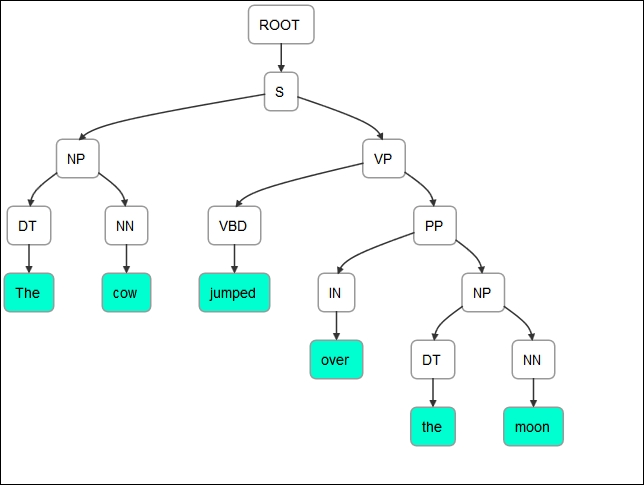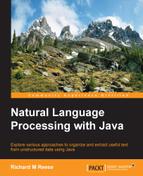Parse trees represent hierarchical relationships between elements of text. For example, a dependency tree shows the relationship between the grammatical elements of a sentence. Let's reconsider the following sentence:
The cow jumped over the moon.
A parse tree for the sentence is shown here. It was generated using the techniques found in Using the LexicalizedParser class later in this chapter:
(ROOT (S (NP (DT The) (NN cow)) (VP (VBD jumped) (PP (IN over) (NP (DT the) (NN moon)))) (. .)))
The sentence can be graphically depicted as shown in the following figure. It was generated using the application found at http://nlpviz.bpodgursky.com/home. Another editor that allows you to examine text in a graphical manner is GrammarScope (http://grammarscope.sourceforge.net/). This is a Stanford supported tool that uses a Swing-based GUI to generate a parse tree, a grammatical structure, typed dependencies, and a semantic graph of text.

However, there may be more than one way of parsing a sentence. Parsing is difficult because it is necessary to handle a wide range of text where many ambiguities may exist. The following output illustrates other possible dependency trees for the previous example sentence. The tree was generated using OpenNLP, as will be demonstrated in the Using OpenNLP section later in the chapter:
(TOP (S (NP (DT The) (NN cow)) (VP (VBD jumped) (PP (IN over) (NP (DT the) (NN moon)))))) (TOP (S (NP (DT The) (NN cow)) (VP (VP (VBD jumped) (PRT (RP over))) (NP (DT the) (NN moon))))) (TOP (S (NP (DT The) (NNS cow)) (VP (VBD jumped) (PP (IN over) (NP (DT the) (NN moon))))))
Each of these represents a slightly different parse of the same sentence. The most likely parse is shown first.
